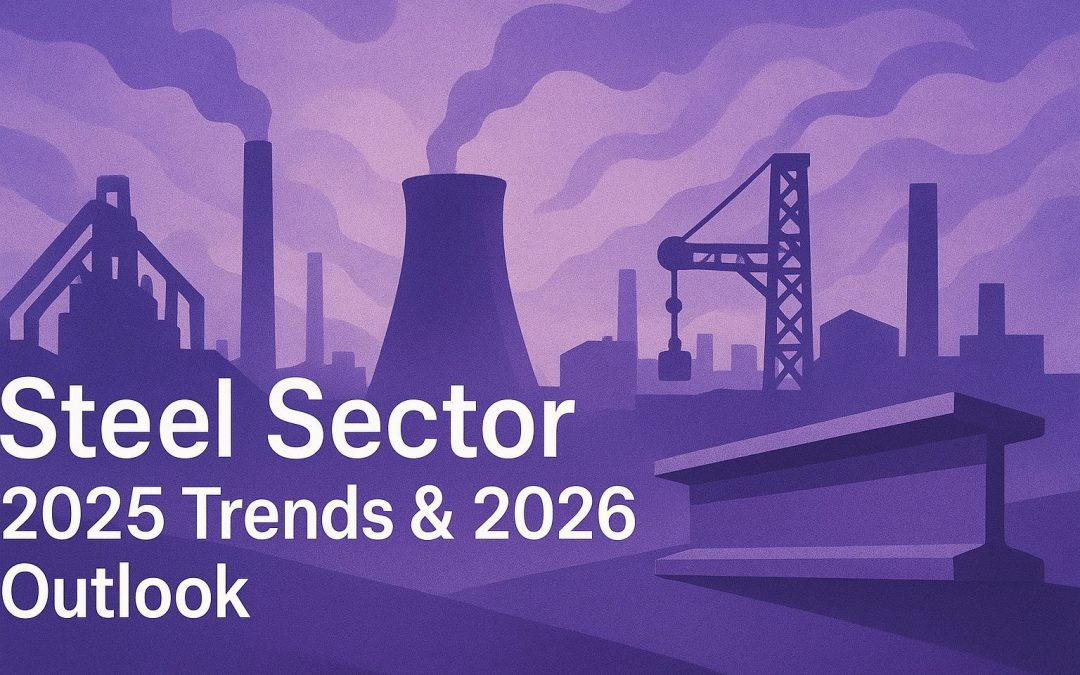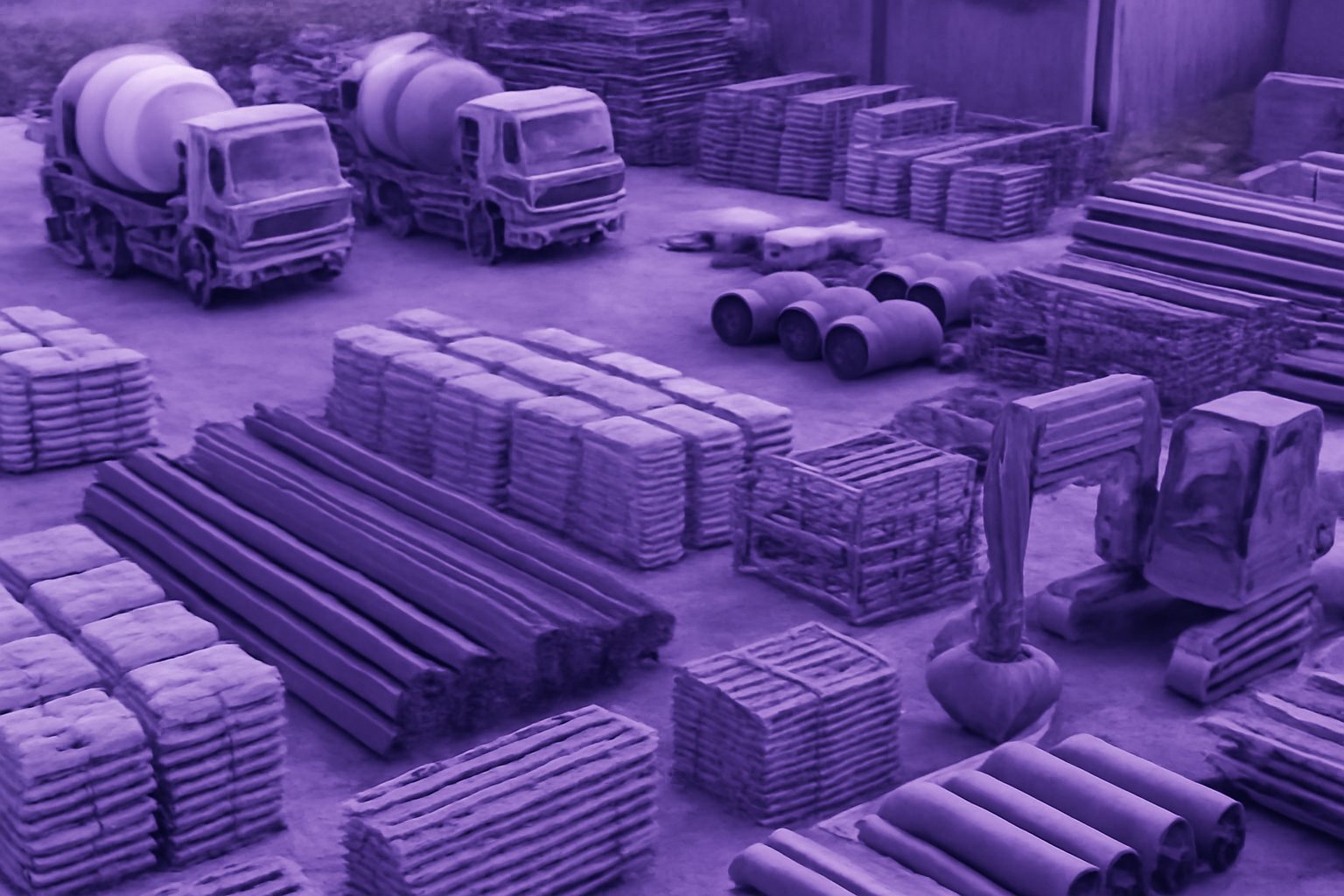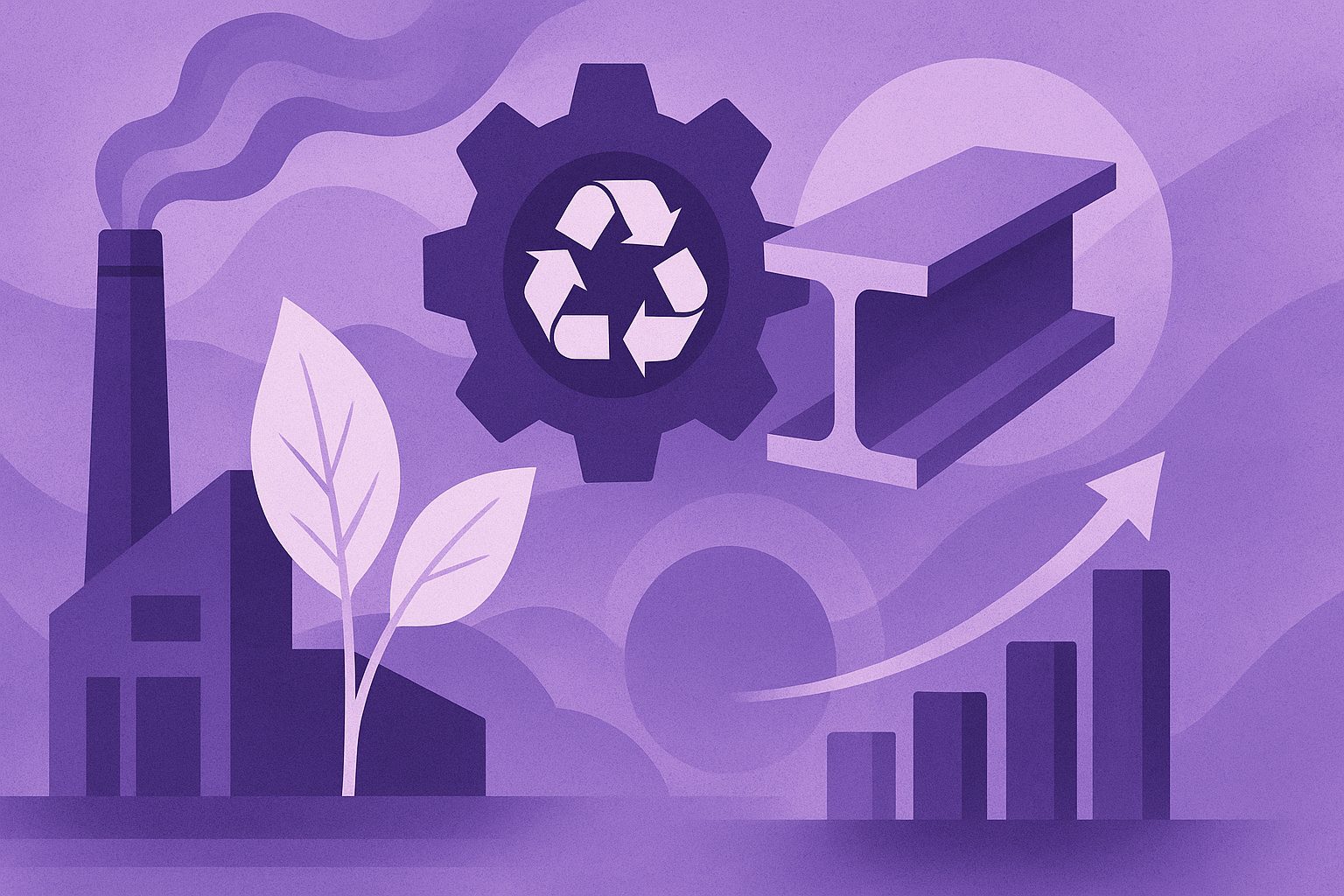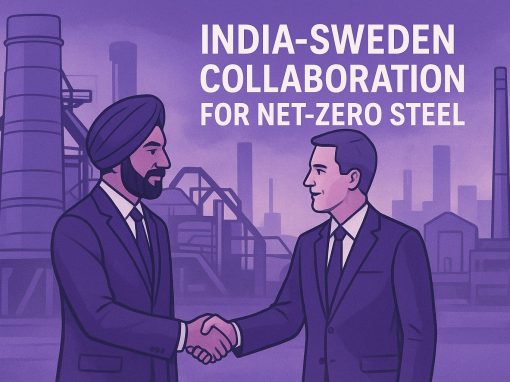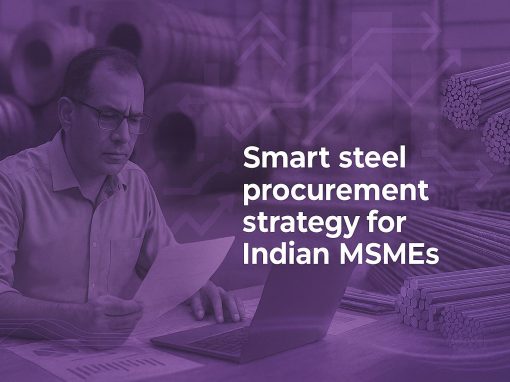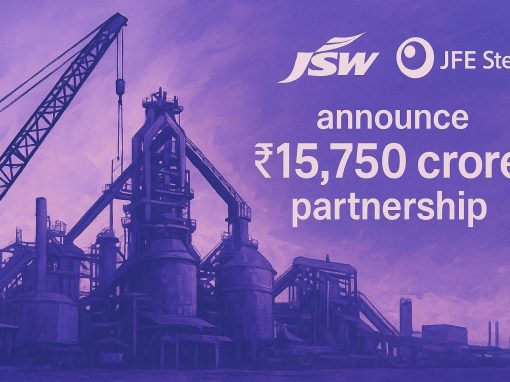Table of Contents
The steel industry in 2025 stands at a defining crossroads – driven by sustainability, technological transformation, and global infrastructure expansion. As nations accelerate toward net-zero goals, the future of the steel sector is being shaped by the rapid adoption of green steel production, hydrogen-based manufacturing, and digital innovation across supply chains.
From smart manufacturing systems powered by AI to decarbonisation strategies that redefine how steel is produced and consumed, the sector is evolving faster than ever. These steel industry trends in 2025 highlight not only a shift toward low-carbon technologies but also a broader movement toward a circular and resilient economy.
In this article, we explore the major forces influencing the future of the steel sector, the role of sustainability in shaping industrial policies, and how innovations in digital transformation and green manufacturing are redefining steel’s place in a rapidly changing world.
Overview of the Global Steel Sector
History and Evolution of the Steel Industry
The steel industry’s journey began in the 19th century. Early steel production involved labor-intensive processes. With advancements like the Bessemer process, efficiency increased dramatically. Over the decades, technologies like electric arc furnaces revolutionised the industry, paving the way for today’s smart manufacturing systems.
Current Trends Shaping the Industry
In 2025, the global steel sector is evolving rapidly, driven by digital transformation, sustainability, and decarbonisation goals. Emerging trends include the adoption of green steel, AI-powered production monitoring, and circular economy models. Steelmakers are investing heavily in low-carbon technologies and energy-efficient methods to align with global net-zero targets.
Global Steel Market Outlook 2025
The global steel market was valued at around USD 935 billion in 2024 and was projected to reach USD 980 billion by 2025, growing at a CAGR of approximately 3.5% (2024–2030). Total crude steel production stood at 1.86 billion tonnes in 2024, with Asia accounting for over 70% of the output.
Key Players and Major Steel-producing Countries
China continues to dominate global steel production, contributing over 1 billion tonnes annually, followed by India, Japan, and the United States. Leading companies include ArcelorMittal, Nippon Steel, POSCO, and Tata Steel, each investing in green hydrogen and digital infrastructure to maintain competitiveness.
Global Steel Production & Market Value (2023–2025)
| Year | Crude Steel Production (billion tonnes) | Market Value (USD billion) | YoY Production Change |
| 2023 | 1.84 | 920 | — |
| 2024 (est.) | 1.86 | 935 | +1.09% |
| 2025 (proj.) | 1.90 | 980 | +2.15% |
Average CAGR (2024–2030): ~3.5% (projected)
Source: Global steel market outlook 2025; compiled from industry estimates and World Steel Association data.
What the Steel Sector Experienced in 2025
Infrastructure Expansion Driving Global Steel Demand
In 2025, the global steel industry experienced a steady upswing driven by massive infrastructure development across Asia, the Middle East, and Africa. Global steel demand grew by approximately 2.5% year-on-year, reaching 1.9 billion tonnes in total crude steel production. Countries like India and China accounted for the bulk of new demand, driven by government-led housing, transportation, and renewable energy projects.
Technological Advancements and Digital Transformation
Steel manufacturers accelerated their adoption of AI, IoT, and predictive analytics in production lines. Smart systems improved operational efficiency, optimised raw material usage, and enhanced quality control. Automated mills and robotics also minimised human intervention, reducing both downtime and safety incidents.
Price Volatility and Market Adjustments
Steel prices in 2025 remained highly volatile, fluctuating between USD 650–720 per tonne due to varying raw material costs and geopolitical trade frictions. Despite the instability, efficient supply chain management and diversified sourcing strategies helped major producers maintain profitability.
Decarbonisation and Green Steel Acceleration
The year also marked a turning point in green steel innovation. Companies such as SSAB, ArcelorMittal, and Tata Steel advanced their hydrogen-based and carbon capture technologies, aligning with global net-zero initiatives. Several pilot plants transitioned to low-emission or fossil-free steel production, signaling a major leap toward sustainability and long-term resilience in the steel sector.
Rise in Domestic Steel Exports
In 2025, India’s steel exports grew by nearly 12% year-on-year, driven by strong demand from Southeast Asia and the Middle East. Competitive pricing and improved port logistics positioned India as a key regional steel supplier.
Scrap Recycling and Circular Economy Growth
The Indian steel industry saw a major push toward scrap-based steelmaking, with new recycling hubs set up under the Steel Scrap Recycling Policy. This helped reduce import dependency and lower overall carbon emissions from primary steel production.
What’s Ahead for the Steel Sector in 2026
Key Innovations in Steelmaking Technologies
By 2026, hydrogen-based steelmaking is expected to move beyond pilot stages into commercial-scale adoption, especially across Europe and Asia. This transition will significantly reduce the sector’s carbon footprint, making green steel a mainstream reality. Breakthroughs in electrolysis-based iron reduction and plasma smelting are also likely to redefine cost efficiency in production.
Increased Digital Transformation and Smart Manufacturing Practices
The steel industry will continue to evolve toward Industry 5.0, blending human expertise with advanced automation. IoT-enabled production lines and AI-driven maintenance systems will allow real-time adjustments, minimise downtime, and enhance output precision. Predictive analytics will also become standard for energy optimisation and process control.
Emerging Markets Boosting Steel Consumption
Emerging economies in Africa, Southeast Asia, and Latin America are projected to account for nearly 20% of global steel demand growth in 2026. Urban housing, energy infrastructure, and transport systems will drive the need for construction-grade and specialty steels. These regions are expected to become the next growth frontiers for steel producers and investors.
Stricter Policies and Regulations Driving Sustainability
Governments worldwide are tightening carbon intensity targets and linking trade access to emission performance. In 2026, countries within the EU and Asia-Pacific are expected to expand carbon border adjustment mechanisms, incentivising clean production. Policy-backed support for green hydrogen and scrap recycling programs will further accelerate sustainability investments.
Growth of Advanced Steel Alloys for High-Tech Applications
Research into lightweight, high-strength alloys will intensify in 2026, particularly for electric vehicles (EVs), renewable energy equipment, and medical devices. Steel grades with improved corrosion resistance and heat tolerance will see greater demand across aerospace and defense sectors.
Market Forecast 2025–2026
The global steel market is projected to grow from USD 980 billion in 2025 to approximately USD 1.03 trillion by 2026, reflecting a compound annual growth rate (CAGR) of around 4%. Crude steel output is expected to exceed 1.93 billion tonnes, supported by stable construction activity and industrial demand.
Green Steel: The Future of Low-carbon Production
| Subtopic | Description/Insights (2025–2026) |
| Challenges in Decarbonising Steel Production | Decarbonisation remains complex due to high energy consumption and transition costs. Producing green steel requires new infrastructure and access to renewable energy sources. Hydrogen-based processes currently cost 25–30% more than traditional methods, but costs are expected to decline by 2030. |
| Renewable Energy Integration in Steel Plants | Major producers are increasingly adopting solar and wind-powered steelmaking. Tata Steel in India has commissioned solar-powered blast furnaces, while POSCO and ArcelorMittal are investing in wind-integrated hydrogen steelmaking. |
| Hydrogen-Based Steelmaking | Hydrogen-based direct reduction is emerging as the key technology for low-carbon steel production. Global hydrogen steel output reached 2.5 million tonnes in 2025, projected to exceed 5 million tonnes by 2027. |
| Successful Green Steel Practices (Case Studies) | ArcelorMittal’s XCarb, SSAB’s HYBRIT, and Tata Steel’s green hydrogen pilot are leading examples of decarbonisation. These initiatives collectively reduced over 3 million tonnes of CO₂ emissions in 2025 alone. |
| Government Support and Global Policies | Governments are providing tax credits, subsidies, and carbon incentives to support low-carbon transitions. The EU’s Carbon Border Adjustment Mechanism (CBAM) and India’s National Green Hydrogen Mission are accelerating global adoption. |
By 2030, green steel production is expected to account for nearly 15% of global output, driven by advances in hydrogen steelmaking and renewable energy integration.
This shift marks a pivotal move toward a low-carbon, sustainable steel industry worldwide.
Technological Innovations in the Steel Sector
The steel industry is rapidly evolving through digital transformation and the adoption of smart manufacturing technologies. As global competition and sustainability goals intensify, innovations like AI, blockchain, and Industry 4.0 frameworks are reshaping production efficiency and transparency.
- AI in Steel Manufacturing: Artificial Intelligence and Big Data are enhancing quality control and predictive maintenance. AI-driven analytics detect production anomalies, optimise furnace operations, and improve overall efficiency.
- Automation and Robotics: Robotic systems and automated cranes now handle complex and hazardous tasks, improving plant safety and productivity while reducing human error.
- Digital Twin and Industry 4.0 Integration: Digital twin technology enables virtual simulation of steel plants for predictive maintenance and performance optimisation. Combined with Industry 4.0 systems, it ensures seamless data flow and real-time monitoring across operations.
- Blockchain for Traceability: Blockchain enhances supply chain transparency by tracking raw materials and verifying green steel or low-carbon steel origins, helping companies meet global sustainability standards.
- Emerging Technologies like 3D Printing: 3D printing with steel supports customized and lightweight designs, particularly in aerospace and construction, contributing to material efficiency and innovation.
Together, these advancements position the sector for a smarter, more sustainable future where data-driven decision-making, automation, and transparency define the next generation of steel production.
Steel Sector’s Role in Infrastructure Development (2025 Outlook)
Importance of Steel in Modern Infrastructure Projects
Steel continues to be the backbone of global infrastructure in 2025, supporting urban expansion, transport modernisation, and energy transitions. High-speed rail networks in Asia and Europe, along with bridge and metro projects in developing regions, are driving strong demand for structural and reinforcement steel.
Prefabricated Steel Structures: A Growing Trend
The adoption of prefabricated and modular steel construction has surged in 2025. These solutions reduce project timelines and labor costs, with modular bridges and building components gaining popularity in India, the Middle East, and Southeast Asia.
Steel’s Role in Green Buildings and Sustainable Infrastructure
With governments emphasising sustainable construction steel, 2025 saw a major shift toward green-certified buildings. Recyclable and energy-efficient steel is increasingly used in smart cities and eco-friendly infrastructure, aligning with global net-zero goals.
Major Infrastructure Projects of 2025 and Future Prospects
Mega projects such as India’s Gati Shakti corridors, the Saudi NEOM city, and Africa’s Trans-African Highway underline steel’s pivotal role in shaping infrastructure. In 2025, global infrastructure steel consumption grew by an estimated 3.2% year-over-year, reflecting strong investment momentum expected to continue into 2026.
Conclusion
The steel industry future in 2025 is defined by sustainability and innovation.Driven by green steel, digital transformation, and AI-powered manufacturing, the sector is moving toward cleaner and smarter production. As demand for sustainable steel grows, these advancements ensure global competitiveness. The industry now stands at the forefront of low-carbon innovation and sustainable growth.
Looking to procure steel?
Tata nexarc helps manufacturers, builders and MSMEs source certified steel products, compare prices, and choose the right grade as per IS codes—with complete traceability and procurement confidence.
FAQs
What are the key steel industry trends in 2025?
What is the global steel market outlook for 2025?
How is the steel sector contributing to sustainability?
What is green steel and why is it important?
How is digital transformation changing steel manufacturing?
Which countries lead global steel production in 2025?
What role does steel play in infrastructure growth?
How volatile are steel prices in 2025?
What innovations are shaping the future of the steel industry?
What’s the future of the steel sector beyond 2025?
A product manager with a writer's heart, Anirban leverages his 6 years of experience to empower MSMEs in the business and technology sectors. His time at Tata nexarc honed his skills in crafting informative content tailored to MSME needs. Whether wielding words for business or developing innovative products for both Tata Nexarc and MSMEs, his passion for clear communication and a deep understanding of their challenges shine through.
